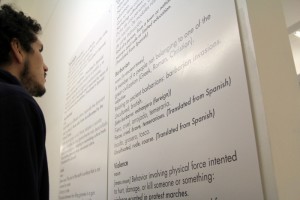This month, talented artist Carlos Colín will be dedicating an exhibit to the impact of language in our daily life and the definitions that surround it. Definitions will compare, well, definitions from the English language and from his first language, Spanish. Colín’s exhibit will stress the importance and power of language.
“Philosopher, poet, and writer Octavio Paz says that language is knowledge. So simple like that, if you don’t understand your language, your knowledge is short or your knowledge is not enough to understand your environment,” says Colín. “I think it’s a good definition on how to use language.”
Colín was born in Guadalajara, Jalisco, Mexico. He was raised in Mexico City, where he grew as an artist and completed a Master’s of Fine Arts at the National School of Fine Art.

Colín received a scholarship from his university in Mexico, so he decided to move to Vancouver in 2011 to complete a second Master’s of Fine Arts at the University of British Columbia. When Colín moved to Canada, the language wasn’t the only difference that stood out to him; with Colín’s education, he has been lucky enough to compare the two countries’ view of art in an academic setting.
“The idea of art changes according to where you live and where you study. Here in Canada, it’s different because it’s another point of view of what art means and how you produce art related to your environment and your ideologies,” he says.
Colín’s work has been displayed in numerous galleries, and he continues to create more art. It’s a wonder that he hasn’t run out of ideas by now, but he’s able to gather inspiration from everything around him, especially from his baby and his wife.
“I love everything. Even from my family, I receive a lot of inspiration. I like music. I like to read. Comics help. For me, it helps to read a comic at some point or read Octavio Paz; just all these connections that you perceive from everywhere,” says Colín. “Even when you walk in the street, you can get inspiration. Even when you read a book, you are part of something. The inspiration at some point just happens. You have all this background in your head and these ideas running around. It depends on the project, too.”
Art doesn’t necessarily have a clear definition. Artists develop opinions on their own projects, but Colín believes that the audience doesn’t have to follow the artists’ opinion; the audience can still appreciate the art by perceiving it in a different light.
“When you walk into a gallery, or a museum, try to understand the art by yourself. For me, as an artist, I have a specific idea of what I want to produce and what I want to present to you, but that doesn’t mean that’s the only line that you need to understand,” says Colín.
It can be hard to know when a certain piece of work or project is finished and ready for the public’s eye. Colín believes art is done when there’s an object that’s ready to be presented, but the art itself may never be finished.
“Work is finished when you present it, but the ideas around it and the life of the artwork is neverending,” says Colín. “There’s a difference between when you finish the object and when you finish the art.”
Definiciones (Definitions)
Until Sunday, April 19
$13 ($11 for students), Art Gallery of Greater Victoria
aggv.ca
